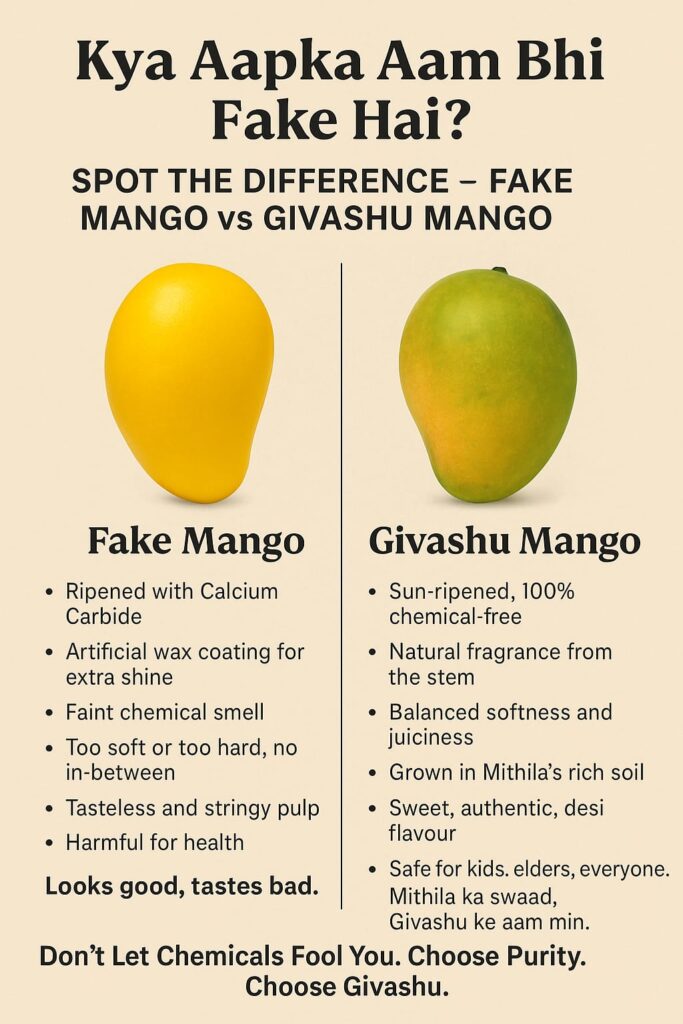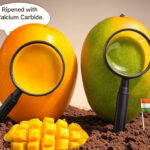Pre-Booking Mangoes:
Trend nahi, zarurat hai!

If mango season had a villain, it wouldn’t be the summer heat or the fruit flies. Nope. It would be the fake mango—the one that looks innocent on the outside but is secretly loaded with chemicals and drama.
So, the question is loud and clear: “Kya aapka aam bhi fake hai?”
Don’t worry, we’re not pointing fingers (yet). But if your mango smells like a chemical lab and tastes like disappointment, then Houston, we have a problem.
Welcome to Givashu Agrotech’s ultimate mango-check guide—where we peel the truth, slice the facts, and pit the fakes. Let’s decode the mango game.
Let’s clear the air—fake mangoes aren’t made in a factory (though they might as well be). They’re real mangoes, yes, but unnaturally ripened using chemicals like calcium carbide, coated in wax for that showroom shine, and sometimes even injected with food dyes for “ripe” appeal.
Basically, these are the catfishes of the fruit world.
Pretty on the outside, sketchy on the inside.
Ah, calcium carbide. The favorite shortcut of fruit mafias everywhere.
This industrial chemical is used to force mangoes to ripen faster, making them market-ready before their time. Sounds efficient? Maybe. Sounds safe? Absolutely NOT.
Why it’s bad:
Contains arsenic and phosphorus residues
Can cause dizziness, nausea, and stomach issues
Banned in many countries (including India)—but still widely used because, you know… jugaad
If your mango ripened overnight, has a strong chemical smell, and is way too yellow too soon—it might be a victim of the carbide con.
We all like shiny things. But mangoes that look like they’ve been polished for a Bollywood red carpet? Hmm.
Wax-coated mangoes are meant to “extend shelf life” and make fruits look fresh. But the wax used isn’t always food-grade. Sometimes it’s the same stuff used in floor polish.
Pro tip: Rub the mango with your palm. If it feels like a candle, run.
Alright detective, let’s break down how to catch the fakes red-handed (or yellow-skinned):
a. Smell Test – The OG Detector
Real mangoes have that irresistible fruity aroma near the stem.
Fake mangoes smell like hardware store on a hot day. If your mango stinks like chemicals, it’s probably cooked up in a lab, not nature.
b. Color Consistency
Natural mangoes ripen unevenly. You’ll find a mix of green, yellow, maybe a tiny brown spot.
But fake mangoes? They look like they’ve been spray-painted. Too uniform = too suspicious.
c. Softness Check
Press gently. Real mangoes are slightly soft when ripe—not squishy like a stress ball, not hard like a cricket ball.
Chemically ripened mangoes go from rock hard to soggy mess in a day. Red flag alert.
d. The Juice Factor
Cut open a mango. If it’s oozing juice and smells heavenly, you’re good.
If it’s dry, pale, or stringy with no flavor—nuksaan ho gaya bhai.
e. Taste Test
You really can’t fake the flavor.
Givashu mangoes taste like nostalgia, summer holidays, and dadi ke haath ka aamras.
Fake mangoes taste like regret and plastic.
f. Peel Check
Peel a mango. If the skin comes off easily and the flesh is vibrant, it’s the real deal.
Tough skin or gray patches under the peel? Suspicious activity detected.
g. Ripening Speed
Bought a hard mango yesterday and it’s fully ripe today? Congratulations, you’ve probably met a carbide mango.
Beyond your taste buds, fake mangoes mess with your health and the environment.
Your body:
Digestive issues
Skin allergies
Long-term exposure can impact lungs and brain
The planet:
Chemical run-offs from artificial ripening setups seep into soil and water
It promotes wasteful agricultural practices
Basically, fake mangoes are bad news—both for you and your maati.
Look, you can’t rush greatness. A real mango, grown in fertile soil, kissed by the sun, and ripened naturally, takes time.
At Givashu Agrotech, we don’t believe in shortcuts. We believe in:
Traditional ripening using hay and sunlight
No artificial chemicals
Hand-picked and sorted by mango lovers, not machines
Each mango tells a story. Of patience. Of care. Of Bihar’s legendary orchards.
Mithila ka swaad, Givashu ke aam mein basaa hai.
Before you buy, always ask:
1. Where is the mango from? (Region matters!)
2. Is it naturally ripened?
3. Does the vendor guarantee chemical-free produce?
4. Can you smell the mango before buying?
5. Is the skin too perfect?
Or better yet—skip the guesswork and buy directly from www.givashuagrotech.com, where premium meets purity and mangoes come with a legacy, not labels.
Let’s settle this once and for all:
We grow Jardalu, Malda, Amrapali, Chausa, Gulabkhaas, and more—all curated by experienced farmers and delivered to your doorstep, farm-fresh and fabulous.
Golden, juicy, desi delight,
You shine with pride in summer light,
But fake ones lurk in every cart,
They break our trust and hurt the heart.
Givashu’s mangoes, pure and true,
Come from orchards kissed by dew,
No chemicals, no shady game,
Just real fruit, and real fame.
Look, mangoes are not just fruits. They’re emotions. And no one wants their emotions tampered with by chemicals and shortcuts.
So this season, don’t just buy mangoes. Choose mangoes that are real, ethical, and delicious.
Choose Givashu Agrotech—where every mango is hand-checked, sun-ripened, and delivered with love.
Kya aapka aam bhi fake hai?
Not anymore. Not when you have Givashu.
Book now on www.givashuagrotech.com and bring home the real taste of summer!




Trend nahi, zarurat hai!
